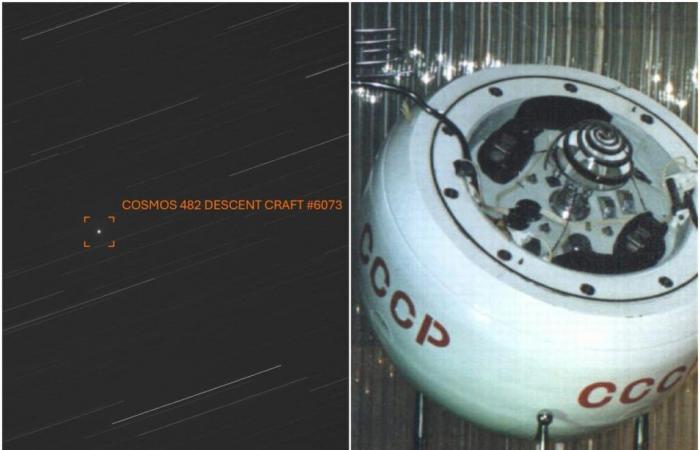And Spatial object launched by the Soviet Union In 1972 will enter the Earth’s atmosphere again in May 2025more than five decades after being put into orbit. It is about Kosmos 482 descent modulea component of an interplanetary mission that failed in his attempt to get to Venus.
This space probe that It approaches the earth It is believed to be the landing module of the failed Soviet mission to Venus. With an approximate weight of 495 kilograms and a diameter of approximately one meterthe ship has surrounded the planet in an increasingly decadent elliptical orbit.
According to estimates by the National Aeronautics and Space Administration (NASA), The reentry of the object could occur between May 9 and 11, with a greater probability on Saturday 10. Although it is not yet possible to determine the place of impact, it is It foresees that this occurs inside a strip that goes from the 52nd north latitude to 52 ° South.
Kosmos 482 was launched on March 31, 1972just days after its successful twin mission, Venera 8. Both spacecraft were part of the ambitious Soviet program destined to explore Venus.
While Venera 8 reached Venus successfully and transmitted data from its surface for 50 minutes on July 22, 1972, according to data provided by the American astronomer Jonathan McDowell, Kosmos 482 found a critical failure.
The first three stages of the rocket worked as planned and the ship was placed in land orbit at an altitude of 196-215 kilometers. However, The fourth stage engine went out prematurelyso it only worked for two minutes of a four -minute planned burning.
This failure left the ship stranded in an elliptical terrestrial orbit of 206-9800 kilometers instead of sending it in a trajectory to Venus. According to the protocols of the Soviet space program, the failed mission retained its generic designation “Kosmos” instead of receiving a “Venera” name.
American monitoring systems initially detected three objects in similar orbits after launch:
The main nave and rocket stage re -entered the relatively rapid earth atmospherein 1981 and 1983 respectively. However, the third object, cataloged as 1972-023E (Object 6073)has remained in orbit much longer due to its unique characteristics.
-In 2000, astronomer Jonathan McDowell identified this remaining object as potentially The descent module for Venus, which had separated from the main spacecraft. This evaluation was based on the cross section of the object of approximately one meter.
Recently declassified Russian documents have provided more clarity about the identity of the object. As published in X the Russian space historian Anatoly zakit was revealed that The separation of the landing module was a deliberate decision of the Soviet missions controllers.
A meeting of the State Commission on April 28, 1972, approximately one month after the failed launch, It issued an order to separate the decrease module from the orbital module of the vehicle No. 671 (Kosmos 482). This operation was probably carried out as a test or possibly to reduce the mass of the object before its inevitable reentry to the earth.
What makes this reentry particularly remarkable is the construction of the probe. The landing module was designed to withstand the harsh conditions of the Venus atmospherewhich are significantly more demanding than the Earth’s atmosphere.
The descent probe has a titanium protective housingessentially a rounded metal container. This robust construction was designed to survive:
Due to this reinforced design, experts believe that The module could potentially survive intact to re -entry through the Earth’s atmosphere and reach the surface. However, it is unlikely that the parachute deployment system works after 53 years in space with exhausted batteries, which means that The impact could be significant.
According to the monitoring analysis of Savings suffer, The re -entry is expected to occur around May 10, 2025with a margin of error of approximately one day.
Computer models suggest that if the module survives at the atmospheric re -entry without breaking or experiencing extensive ablation, could impact the earth’s surface at approximately 242 km/h. This gives the object a kinetic energy similar to a 40-55 centimeters meteorite fragment after ablation.
Re -entry is uncontrolledwhich hinders the precise predictions of location. With an orbital inclination of 51.95 degrees, the landing It could happen anywhere between the 52 ° of north latitude and the 52 ° southern latitudewhich covers most of the populated areas of the world.
The exact moment and location of atmospheric re -entry They should know more accurately in the next few daysbut significant uncertainty will continue to the real event. Experts emphasize that although The risks involved are not particularly high, nor are they null.






